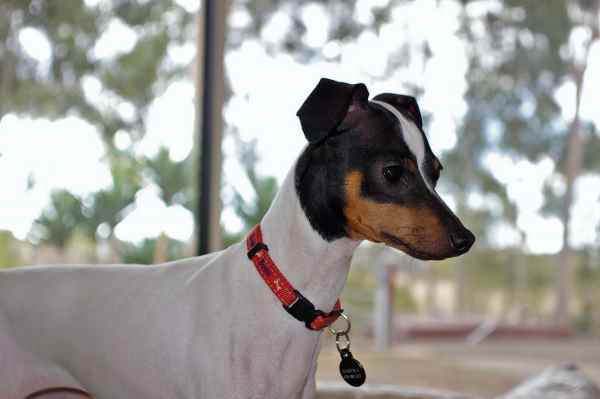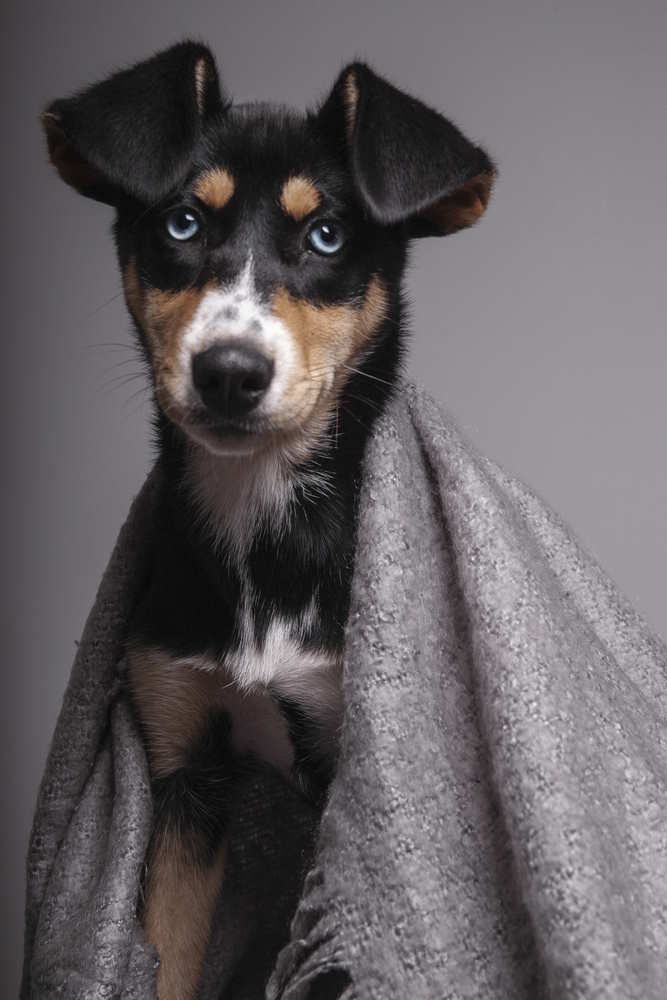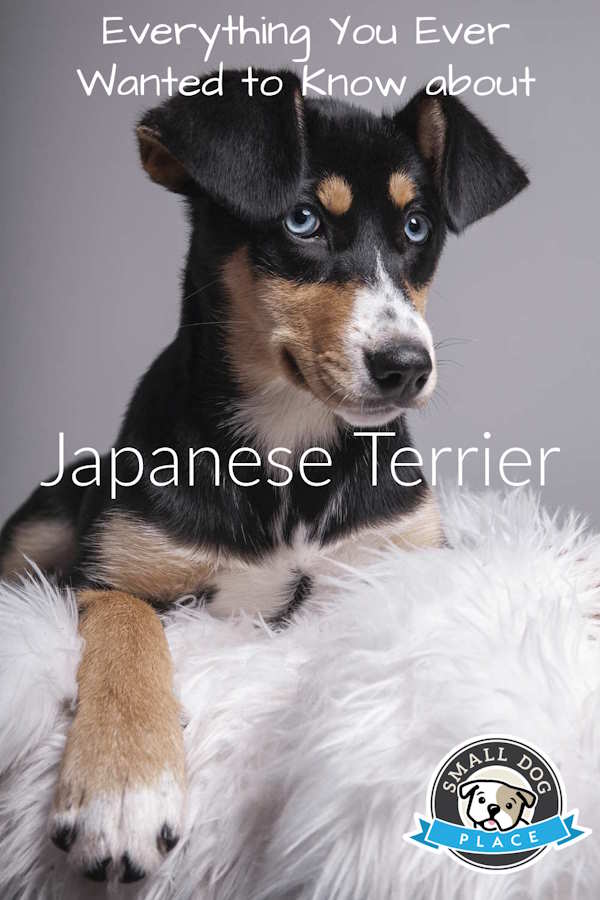Japanese Terrier Complete Dog Breed Profile
by Janice Jones |Last Updated 07-05-2023
The Japanese Terrier is an extremely rare breed, even in Japan where it was first developed.
They are small, lively, affectionate and loyal, making them a popular choice as a pet dog. You’ll may find them lounging on the sofa, but they do need exercise to keep the mind and body active. A 30-minute walk is all that is necessary to keep the Japanese Terrier happy.
Their sensitive nature makes them well suited to singles, couples, and families that have older kids. Loud, rambunctious children can scare them so this type of environment is not recommended.
Typical of the terrier breeds that went into their development The Japanese Terrier is a balanced, square dog, with a smooth, slick and short coat. Their heads are almost always black with a white body that has little black spots.
They hold their ears upright and their tails are normally docked in Japan. In countries where tails are not permitted to be docked, the tail is slightly curved and tapered at the end.
They tend to tolerate the heat better than the cold and will need a sweater or coat if living in a cold climate.
Quick Facts About the Japanese Terrier
Other Names Used: Nippon Terrier, Nihon Teria, Nihon Terrier, Kobe Terrier, Mikado Terrier, Oyuki (Snowy) Terrier
Affiliation: JKC Japanese Kennel Club, FCI, UKC (Terrier Group)
Height: 8-13 inches
Weight: 5-9 pounds
Coat Type: Smooth, sleek, thick, short coat
Colors: Black head with white body. Tan spots on the white body
Country of Origin: Japanese
Activity Level: Energetic
Life Expectancy: 11-15
years
Good with Children: Older
Children and younger children if supervised
Good with other pets: They
are good with other dogs and cats but should not be trusted around small pocket
pets such as hamsters or gerbils because they will be seen as possible prey.
Explanations for At a Glance Ratings
- Playfulness: Most=5 Less=1
- Affection: Most=5 Least=1
- Friendliness Towards Strangers: Most=5 Least=1
- Good with Children: Good=5 Not Good=1
- Good with Other Dogs: Good=5 Not Good=1
- Good for First Time Owners: Good=5 Not Good=1
- Amount of Exercise Required: Much=5 Minimal=1
- Ease of Training: Easy=5 Difficult=1
- Watch Dog Ability: Excellent=5 Poor=1
- Grooming Needs: Extensive=5 Minimal=1
- Shedding: Heavy Shedding=5 Minimal Shedding=1
- Cold Tolerance: Cold Well Tolerated=5 Poorly Tolerated=1
- Heat Tolerance: Heat Well Tolerated=5 Poorly Tolerated=1
History of Japanese Terriers
 Japanese Terrier
Japanese TerrierThis is a very rare dog breed even in Japan. It is generally assumed that they descended from Smooth Fox Terriers who arrived with Dutch sailors in the 17th century and have remained throughout the centuries similar in size and even colors.
Even so, there is some confusion as to whether the Japanese Terrier descended from the Dutch Boerenfox (a Dutch terrier strain, like the Fox Terrier of England or the German Pinscher of Germany).
Alternately, they could have been dogs brought by English sailors at approximately the same time. Whichever was the original breed they all arrived in the ports of Nagasaki, because was the only port open to the West.
These little dogs quickly became popular because their size made them ideal lap dogs and companions.
Their ancestors were originally used to manage the vermin population both onboard merchant ships as well as on land. The Japanese Terrier may have been used for this purpose, but they were primarily developed as a companion.
Once in Japan, they were bred with local dogs and small pointer type dogs.
By the 1930s, a fairly standard type emerged and was a popular companion and lap dog in the Japanese cities of Nagasaki, Kobe and Yokohama. They were first recognized by the Japanese Kennel Club in 1930.
This very rare breed nearly vanished in 2nd World War when Japan faced tough times. They did reimerge and was first accepted by the FCI in 1998. These were admitted to United Kennel Club in 2006.
Personality Traits of Japanese Terriers

This breed is very loyal and charming and a bit home spirited as
well. They have a calm and friendly nature.
The temperament of Japanese Terriers
is playful and actively agile but they can also show signs of mischief from time to time.
They adapt to urban life and can stay in Flats and apartments with some daily exercise and a routine that consists of walks.
Also known
as Nipon Terrier or Nihon Terrier, this breed finds it difficult to accommodate
itself to extreme climate conditions and needs blankets to keep itself warm in
winters.
Terriers love their toys. They get super excited when they
receive a new toy as a gift. Nihon Terriers are companion dogs and they like to
interact with family members. They tend to be rather possessive of certain family members
who they feel close.
They enjoy playing with older children but I would advise
parents to keep smaller children away from this breed of dogs. They hate loud noises and the terrier instincts may come out when you least expect it to happen.
Japanese Terriers have the ability to become good watchdogs as
they can hear even slightest of voices and have good eyesight as well. They don’t, however, make good guard dogs due to their size.
Grooming
Grooming a short hair breed such as this one is a breeze with this breed. A brush with soft bristles, cloth, or rubber curry glove is all that is needed once in awhile. Brushing will help with shedding but these dogs are not known to be big shedders.
A bath when dirty is also recommended. Other than that, their teeth should be brushed periodically and their nails clipped. A weekly once over will pick up any problems such as dirty ears, fleas, or skin rashes.
Health
Since this is such a rare breed, with such a few member dogs world wide, it is impossible to assess the health status of the breed. It is thought that it is a healthy breed with no health problems being reported.
Pros
- Lively, affectionate lap dog
- Does not require much exercise
- Makes a good watch dog
- Good with Older Children
- Small size makes them very portable
- No known health problems
Cons
- Extremely rare, hard to find
- Do not do well in cold climates
Pin for Future Reference

Does This Article Deserve Your Thumbs Up?
We always appreciate your support and encouragement. Your thumbs up means so much to us. Please like this article.
If you find this page or any page on Small Dog Place Helpful, or Useful in anyway, I’d love it if you would click the small heart found on the bottom right of each page.
You can also share or bookmark this page — just click on the:

Free Monthly Newsletter
Sign Up for Our Free Newsletter and get our Free Gift to You.
my E-book, The Top 10 Mistakes People Make When Choosing a Dog (and how to avoid them)




